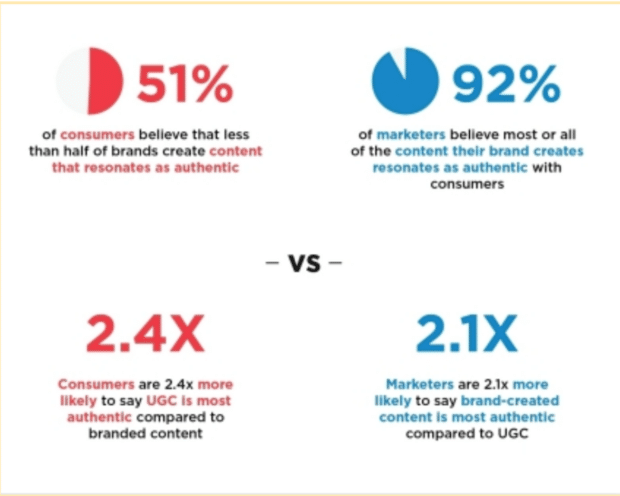Have some cool new clothes you want to show off to the world? You’ll almost certainly take a photo and share it on your social media accounts. Or maybe you got a cool new product and posted an unboxing video to your YouTube channel? Whether you realize it or not, both of these examples are examples of user-generated content (UGC).
Still not convinced? Don’t worry, we’ve got your back.
This article will explain what user-generated content is, as well as a few other things:
- Understand the advantages of incorporating user-generated content into your campaigns,
- Examine how large and small brands use UGC.
- Learn how to turn your user-generated content into more engagement and conversions for your brand.
User-generated content (UGC) is original, brand-specific content created by customers and published on social media or other channels. Images, videos, reviews, testimonials, and even podcasts are examples of UGC.
Calvin Klein’s example of user-generated content.
Where does user-generated content come from?
Customers
Consider unboxing videos on TikTok or praise-filled Instagram posts. Customers are usually the most prominent cohort from which you’ll seek UGC, either because you’ve asked for it or because they’ve decided to share content about your brand on their own.
Brand aficionados
Loyalists, supporters, or fans. Whatever you call your most devoted customers, they are usually the most enthusiastic about your company. Because loyalists are so dedicated to worshiping at the alter of the brand, this audience segment is prime for reaching out to and requesting specific UGC content.
Employees
Employee-generated content (EGC) demonstrates the worth and story behind your brand. Photos of employees packing or assembling orders, for example, or a video of your team discussing why they enjoy working for your company. This behind-the-scenes content contributes to brand identity and works across social and advertising platforms to demonstrate authenticity.
What is the significance of user-generated content?
UGC is used to influence engagement and increase conversions at all stages of the buyer’s journey. Customer-centric content can be used on social media as well as other channels like email, landing pages, and checkout pages.
Takes authenticity to the new level
Nowadays, brands must compete for audience attention by fighting to display online. As a result, buyers, particularly the notoriously fickle Gen-Z, are more selective about the brands with which they interact and purchase.
Consumers aren’t the only ones who care about authentic content. 60% of marketers agree that authenticity and quality are both important components of successful content. And there is no other type of content more authentic than UGC from your customers.
Don’t be tempted to forge user-generated content or a campaign. Audiences will quickly detect false sentiment, which could severely harm your brand’s reputation. Instead, make certain that your UGC comes from one of three groups: customers, brand loyalists, or employees.
People ultimately trust other people, so consider UGC to be the modern-day word of mouth.
And, with consumers viewing user-generated content as 2.4 times more authentic than content created by brands, the time to invest in an authenticity-driven social marketing strategy is now.
Source: Business Wire
Contributes to brand loyalty and community growth
Instead of being a spectator, UGC allows customers to actively participate in the growth of a brand. This has a significant impact on brand loyalty and affinity because people thrive on being a part of something bigger than themselves, and creating UGC allows them to be a part of a brand’s community.
UGC also facilitates conversations between a brand and a consumer, and this level of brand interaction aids in the development and growth of an engaged community.
Sharing audience content also helps to develop and strengthen audience/business relationships, resulting in increased brand loyalty.
Acts as a trust signal
Remember when Fyre Festival was marketed as an “immersive music festival over two transformative weekends,” but the event consisted of rain-soaked tents in a field with no electricity or food? This is why people dislike marketers and advertisers.
In fact, only 9% of Americans trust the media “a great deal,” which is unsurprising given the influx of fake news since the 2020 global pandemic.
Brands must work harder than ever to establish their credibility. And, with 93 percent of marketers agreeing that consumers trust customer-created content more than brand-created content, UGC is the ideal format for businesses to boost their trust score.
Audiences rely on user-generated content (UGC) as a trust signal in the same way they would ask their friends, family, or professional network for advice. Over half of millennials base their purchasing decisions on recommendations from family and friends, so UGC can shine in this area because it is exactly that: a personal recommendation.
Increase conversions and affect purchasing decisions
User-generated content is extremely powerful in the final stages of the buyer’s journey, where you want to convert and influence your audience to make a purchase.
UGC serves as genuine social proof that your product is worth purchasing. For example, your target audience may see people who look like them wearing or using your product, which influences their decision to purchase.
You can even show your non-human customers using your product, as Casper does in Dean the Beagle’s UGC post.
Adaptable and flexible
You can use UGC outside of social media in other marketing campaigns, making the strategy omnichannel.
For example, you could include UGC images in an abandon cart email to nudge the prospective buyer to make a purchase, or you could incorporate user-generated content into key landing pages to boost conversion rates.
Calvin Klein even dedicated a landing page to user-generated content. By displaying real examples of customers styling their Calvins, shoppers see other customers endorsing the brand and demonstrating how the products look on real people rather than overly styled models.
Less expensive and more effective than influencer marketing
Hiring an influencer can cost millions of dollars on average. What is the average cost of asking your customers to share photos of themselves enjoying your product on social media? Nothing at all.
UGC is a low-cost way to expand your business and add a new marketing strategy to the mix. There’s no need to spend money on a flashy creative agency to create brand assets or content for your campaigns.
Simply connect with your audience, who are the most important people in your business. The majority will be thrilled to be featured on your channel.
UGC is less expensive and easier to manage for smaller brands or those just beginning than investing in larger-scale brand awareness campaigns.
Works in conjunction with social commerce
Social commerce, or shopping directly on your favorite social channels, is the future of online shopping. The main advantage of social commerce is that it allows audiences to convert within a social media app rather than going off-network to complete a purchase.
Assume you’re scrolling through Instagram and come across a cute new bathrobe. You tap to learn more about the product, decide whether to buy it and finish the transaction in the app. That is an example of social commerce in action.
UGC and social commerce complement each other well because UGC influences conversions. Nearly 80% of people say user-generated content influences their purchasing decision, making user-generated content and social commerce a match made in heaven.


